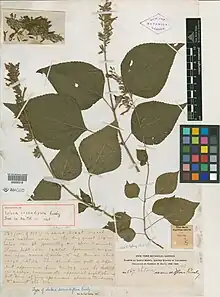| Salvia camarifolia | |
|---|---|
 | |
| Scientific classification | |
| Kingdom: | Plantae |
| Clade: | Tracheophytes |
| Clade: | Angiosperms |
| Clade: | Eudicots |
| Clade: | Asterids |
| Order: | Lamiales |
| Family: | Lamiaceae |
| Genus: | Salvia |
| Species: | S. camarifolia |
| Binomial name | |
| Salvia camarifolia | |
Salvia camarifolia is a perennial undershrub native to the northern and eastern slopes of the Sierra Nevada de Santa Marta in Colombia, growing at elevations from 0 to 1,600 m (0 to 5,249 ft). There is also past evidence of a specimen from the Ocaña region. S. camarifolia grows 1 to 3 metres (3.3 to 9.8 ft) tall, with ovate grey-green leaves that are 6 to 12 cm (2.4 to 4.7 in) long and 3 to 6 centimetres (1.2 to 2.4 in) wide. The red corolla is 1.5 to 2 centimetres (0.59 to 0.79 in) long, with subequal lips that are 4 to 5 centimetres (1.6 to 2.0 in).[1]
Notes
- ↑ Wood, J. R. I.; Harley, R. M. (1989). "The Genus Salvia (Labiatae) in Colombia". Kew Bulletin. Springer. 44 (2): 269–270. doi:10.2307/4110799. JSTOR 4110799.
This article is issued from Wikipedia. The text is licensed under Creative Commons - Attribution - Sharealike. Additional terms may apply for the media files.